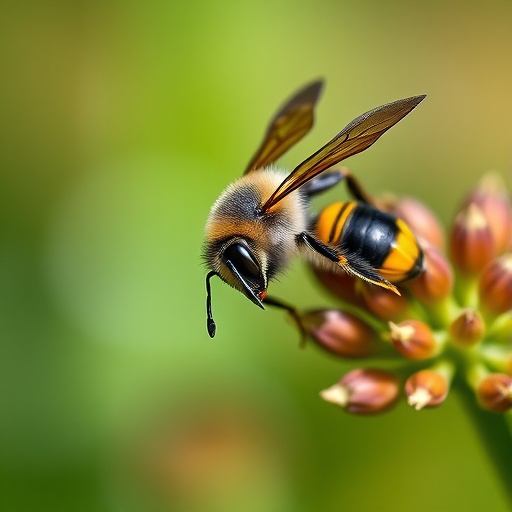In a significant contribution to the understanding of biodiversity and ecosystem health, a recent study has highlighted shifting diversity patterns of non-Apis bees, specifically within the family Apidae, as they navigate through various disturbance gradients found in the Himalayan foothills. This area, characterized by its unique ecological conditions, has come under increased scrutiny due to the profound implications of disturbance on bee populations, crucial pollinators in many ecosystems worldwide. The research aims to provide insights into how environmental changes can affect these non-Apis bees, which include a variety of solitary and social bee species, often overlooked compared to the more commonly studied Apis genus.
Non-Apis bees play a fundamental role in pollination, which has cascading effects on plant reproduction and ecosystem stability. The study, conducted by Mukhtar and colleagues, emphasizes that understanding the biodiversity of these lesser-known but equally vital species is crucial amid growing concerns about global biodiversity loss. The research involved assessing bee diversity across sites experiencing different levels of ecological disturbance, thereby offering a comprehensive view of how such factors influence bee populations and their ecological roles.
Utilizing advanced techniques in field surveys and ecological assessments, the researchers mapped the variations in non-Apis bee diversity at various disturbance gradients. These gradients ranged from minimally disturbed environments to areas heavily influenced by human activities or natural events. This multifaceted approach allowed for a nuanced understanding of the resilience and adaptability of non-Apis bees in the face of environmental stressors. The findings revealed complex relationships between bee diversity and habitat alteration, indicating that some bee species thrive in certain disturbed conditions while others decline drastically.
The implications of the study extend to conservation strategies aimed at enhancing biodiversity and maintaining ecosystem services. As pollinator populations face pressures from habitat loss, climate change, and agricultural practices, understanding the ecology of non-Apis bees becomes increasingly urgent. The research suggests that protection and restoration of habitats, even under diverse disturbance levels, can foster the survival of these important insects. This highlights the need for targeted conservation efforts that consider the unique requirements of non-Apis bees and their ecological niches.
Furthermore, the results of this study contribute to the broader discourse on ecosystem health. Bees are often considered bioindicators, meaning their populations reflect the overall state of the environment. Understanding how non-Apis bees respond to disturbances could serve as a barometer for ecosystem resilience in the Himalayan foothills and beyond. The findings add valuable data to existing literature on pollination biology and biodiversity conservation, providing actionable insights for policymakers and environmental planners.
The researchers emphasize that while Apis bees often receive significant attention due to their role in agriculture and honey production, it is essential not to overlook the myriad of non-Apis species that perform critical ecological functions. This research demonstrates that neglecting these species could have far-reaching consequences on the stability of ecosystems, particularly in regions facing rapid environmental changes. Consequently, increased awareness and investment in research focused on non-Apis bee species could amplify conservation outcomes.
As the global community grapples with climate change and habitat disruption, understanding the dynamics of bee diversity becomes even more critical. The study underscores the importance of comprehensive environmental monitoring and the integration of ecological insights into land-use planning. Policymakers are encouraged to incorporate biodiversity-friendly practices that support a multitude of bee species, ensuring that both agricultural needs and ecological integrity are met.
In addition to its ecological implications, the findings also offer avenues for future research. Investigating specific traits that enable certain non-Apis bees to persist in disturbed areas could yield insights into their evolutionary adaptations and strategies for survival. Moreover, longitudinal studies that track these populations over time would provide a richer understanding of how ongoing disturbances may further change bee community structures.
Finally, this study represents a pivotal step in drawing attention to the often-ignored diversity of non-Apis bees and the essential roles they play in our ecosystems. By reinforcing the significance of these species amidst discussions on biodiversity, the research lays a foundation for more inclusive conservation efforts. The shift in diversity patterns highlighted in this study serves as a call to action for researchers, conservationists, and the global community to prioritize the protection of these vital pollinators, ensuring their continued presence in our changing world.
In the backdrop of the Himalayas, where natural beauty meets ecological significance, studies like these remind us of the interconnectedness of all species and the paramount importance of sustaining biodiversity for future generations. Through collaborative efforts and enhanced awareness, it is possible to foster environments where non-Apis bees can thrive, thus contributing to the overall health of our planet’s ecosystems.
Subject of Research:
Non-Apis Bees Diversity across Disturbance Gradients in the Himalayan Foothills
Article Title:
Shifting diversity patterns of non-Apis bees (family Apidae) across disturbance gradients in a Himalayan foothill landscape.
Article References:
Mukhtar, Y., Shankar, U., Singh, R. et al. Shifting diversity patterns of non-Apis bees (family Apidae) across disturbance gradients in a Himalayan foothill landscape.
Environ Monit Assess 197, 1281 (2025). https://doi.org/10.1007/s10661-025-14707-x
Image Credits:
AI Generated
DOI:
Keywords:
Biodiversity, Non-Apis Bees, Ecosystem Health, Pollination, Conservation Strategies, Environmental Disturbance, Himalayan Foothills.




